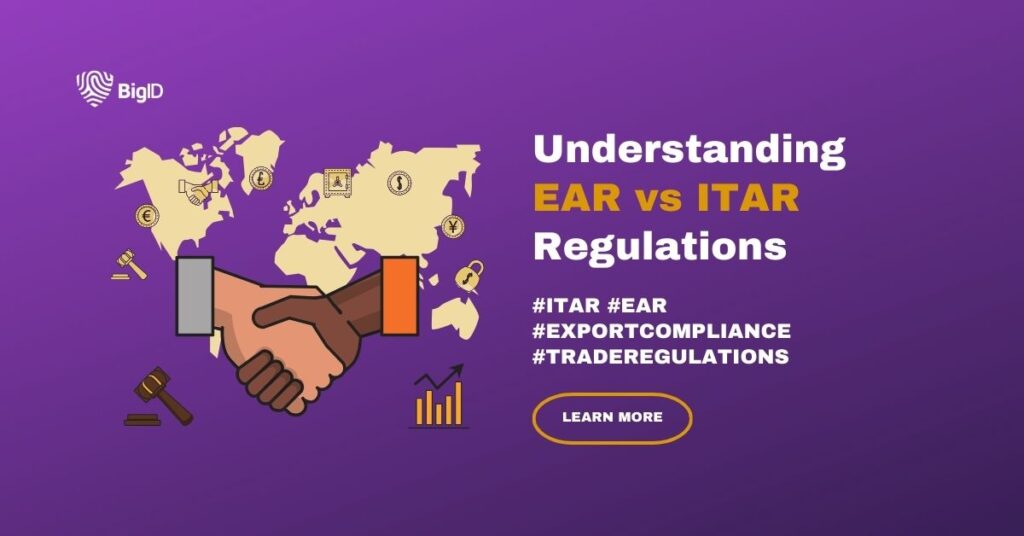Understanding EAR vs. ITAR Regulations

Navigating the Complexities of EAR and ITAR Regulations
In the realm of international trade and national security, the acronyms EAR and ITAR hold significant importance. While both play pivotal roles in regulating the export of goods and technologies from the United States, they cater to different sectors and have distinct requirements. This article delves into the intricacies of the Export Administration Regulations (EAR) and the International Traffic in Arms Regulations (ITAR), providing a comprehensive understanding of their functions, implications, and key differences.
Understanding EAR: Export Administration Regulations
The Export Administration Regulations (EAR) are administered by the Bureau of Industry and Security (BIS) under the U.S. Department of Commerce. EAR governs the export of dual-use items—goods, software, and technology that have both commercial and military applications.
What is EAR?
Scope of Regulation
EAR covers a wide range of items listed on the Commerce Control List (CCL). This includes commodities, software, and technology that could potentially be used for military purposes but are primarily intended for civilian use. Examples include advanced computing technology, telecommunications equipment, and encryption software.
Licensing Requirements
Exporters must determine if their items require an export license based on the destination country, the end-user, and the end-use. The EAR uses the Export Control Classification Number (ECCN) system to classify items and determine licensing requirements.
Deemed Exports
A unique aspect of EAR is the concept of “deemed exports.” This occurs when controlled technology is released to a foreign national within the United States. Such releases are considered exports and may require a license.
Understanding ITAR: International Traffic in Arms Regulations
The International Traffic in Arms Regulations (ITAR) are administered by the Directorate of Defense Trade Controls (DDTC) under the U.S. Department of State. ITAR governs the export and temporary import of defense articles and services listed on the United States Munitions List (USML).
What is ITAR?
Scope of Regulation
ITAR covers items specifically designed, developed, configured, adapted, or modified for a military application. This includes weapons, military aircraft, and defense-related technical data. ITAR regulations are stringent due to the national security implications of these items.
Registration and Licensing
Companies that manufacture, export, or broker defense articles or services must register with the DDTC. Export licenses are required for almost all defense-related exports, including technical data and services. The licensing process is comprehensive, ensuring that the transfer of defense articles does not compromise U.S. national security.
Technical Data and Defense Services
ITAR not only regulates physical defense articles but also the transfer of technical data and defense services. This encompasses blueprints, design plans, and even oral or visual disclosures of controlled technical information.

Comparing EAR and ITAR: Similarities and Differences
Common Ground
Both EAR and ITAR aim to protect U.S. national security and foreign policy interests by controlling the export of sensitive items. They both require exporters to obtain licenses for certain destinations, end-users, and end-uses. Additionally, both sets of regulations impose severe penalties for non-compliance, including hefty fines and imprisonment.
Distinct Differences
Regulatory Bodies and Scope
While EAR is administered by the BIS and focuses on dual-use items, ITAR is overseen by the DDTC and targets defense-related items. This fundamental difference in scope reflects the nature of the items they regulate—commercial versus military.
Classification and Licensing
EAR uses the ECCN system to classify items and determine licensing requirements, whereas ITAR relies on the USML. The licensing processes also differ, with ITAR requiring more stringent scrutiny due to the sensitive nature of defense articles.
Deemed Exports vs. Defense Services
EAR’s concept of deemed exports highlights the importance of controlling technology transfers within the U.S., whereas ITAR’s regulation of defense services emphasizes the broader range of controlled activities, including technical assistance and training.
Prohibited Countries Under EAR and ITAR
Both the Export Administration Regulations (EAR) and the International Traffic in Arms Regulations (ITAR) impose restrictions on exports to certain countries. These restrictions are based on U.S. foreign policy and national security concerns.
EAR prohibited countries include:
- Cuba
- Iran
- North Korea
- Syria
Countries with Significant Restrictions:
- Sudan
- Venezuela
ITAR Prohibited Countries
The Directorate of Defense Trade Controls (DDTC) under ITAR maintains a list of countries to which defense articles and services cannot be exported. These prohibitions align with U.S. foreign policy and security objectives.
Countries subject to arms embargoes include China, Cuba, Iran, North Korea, Sudan, Syria, and Russia.
Compliance with these regulations helps protect U.S. national security and foreign policy interests while promoting global stability and human rights. Exporters must stay informed about the current sanctions and carefully evaluate the destinations, end-users, and end-uses of their products to ensure adherence to these critical regulations.

Penalties and Violations of EAR vs. ITAR
Compliance with the Export Administration Regulations (EAR) and the International Traffic in Arms Regulations (ITAR) is critical for businesses involved in exporting goods, technologies, and services from the United States. Both sets of regulations impose severe penalties for violations, including fines, imprisonment, and administrative sanctions. Understanding these penalties and the types of violations that can trigger them is essential for ensuring compliance and avoiding significant legal and financial repercussions.
EAR Violations and Penalties
Types of Violations
- Exporting Without a License: Shipping controlled items without the necessary export license.
- False Statements: Providing false or misleading information in export documentation.
- Failure to Comply with Recordkeeping Requirements: Not maintaining accurate records of exports and related transactions.
- Engaging in Prohibited Activities: Involvement in activities with denied parties or embargoed countries.
Penalties for EAR Violation
- Civil Penalties: The maximum civil penalty for each violation can be up to $300,000 or twice the value of the transaction, whichever is greater.
- Criminal Penalties: For willful violations, individuals can face up to 20 years in prison and fines up to $1 million per violation. Companies can be fined up to $1 million per violation.
- Denial of Export Privileges: Companies or individuals can be denied the privilege to export for a specified period.
- Administrative Sanctions: These can include suspension or revocation of export licenses and compliance programs.
Case Example
In 2020, a company was fined $1 million for exporting telecommunications equipment to Iran without the required licenses. The violations included both civil and criminal penalties due to the willful nature of the actions.
ITAR Violations and Penalties
Types of Violations
- Exporting Defense Articles Without Authorization: Shipping items listed on the United States Munitions List (USML) without the proper export license.
- Unauthorized Transfer of Technical Data: Sharing controlled technical data with foreign nationals without authorization.
- False Statements and Misrepresentation: Providing false or misleading information in export applications or documentation.
- Failure to Register with DDTC: Not registering with the Directorate of Defense Trade Controls (DDTC) when required.
Penalties for ITAR Violations
- Civil Penalties: The maximum civil penalty for each violation can be up to $1,272,251 (as of 2023) or twice the value of the transaction, whichever is greater.
- Criminal Penalties: For willful violations, individuals can face up to 20 years in prison and fines up to $1 million per violation. Companies can be fined up to $1 million per violation.
- Debarment: Companies or individuals can be debarred, meaning they are prohibited from participating in any activities regulated under ITAR.
- Consent Agreements: Companies may enter into consent agreements with the DDTC, which often include hefty fines and mandated compliance measures.
Case Example
In 2018, a major aerospace company was fined $30 million for ITAR violations related to the unauthorized export of defense articles and technical data. The penalties included a combination of civil fines, consent agreement requirements, and mandated compliance improvements.
Key Differences in Penalties and Enforcement
- Severity of Penalties: While both EAR and ITAR impose severe penalties, ITAR violations generally carry higher maximum civil penalties due to the sensitive nature of defense articles.
- Regulatory Bodies: EAR violations are enforced by the Bureau of Industry and Security (BIS) under the Department of Commerce, while ITAR violations are enforced by the Directorate of Defense Trade Controls (DDTC) under the Department of State. This difference in oversight reflects the distinct focus of each set of regulations—dual-use items for EAR and defense articles for ITAR.
- Scope of Violations: EAR violations often involve dual-use technologies and items that have both commercial and military applications, whereas ITAR violations specifically pertain to defense articles and services. This distinction influences the nature of violations and the corresponding penalties.
Understanding the penalties and violations associated with EAR and ITAR is crucial for businesses engaged in exporting from the United States. Both sets of regulations impose stringent penalties for non-compliance, including significant fines and imprisonment. By maintaining robust compliance programs and staying informed about the latest regulatory requirements, companies can mitigate the risk of violations and ensure their operations align with U.S. national security and foreign policy objectives.
Ensuring EAR and ITAR Compliance with BigID
Any organization subject to ITAR requirements must take concrete steps to secure its defense data and implement a detailed incident response plan in case of a breach of ITAR regulations. BigID is the industry leading platform for data privacy, security, compliance, and AI data management utilizing deep data discovery to empower organizations with greater visibility into their enterprise data.
With BigID organizations can:
- Identify, Classify, and Know Your Data: BigID’s data discovery foundation drills deep inside all structured and unstructured data, on-prem or in the cloud, with multiple connectors to find sensitive data. This allows organizations to inventory, map, classify, and connect data to ITAR requirements — as well as other regulatory policies.
- Reduce Data Access Risk: BigID can flag and investigate high-risk users, groups, and data across an organization. Companies can track and review files containing sensitive data with open access — and produce audit reports of high-risk targets.
- Leverage Risk Scoring: BigID scores risk based on a variety of data parameters like data type and location — and provides a risk-centric view of data so organizations can be proactive about reducing risk while adhering to cybersecurity best practices
To achieve ITAR or EAR compliance today — book a 1:1 demo with our experts today.
FAQs About EAR and ITAR
What is the primary purpose of EAR and ITAR?
Both EAR and ITAR aim to protect U.S. national security and foreign policy interests by regulating the export of sensitive items. EAR focuses on dual-use items, while ITAR targets defense-related items.
Who oversees EAR and ITAR regulations?
EAR is administered by the Bureau of Industry and Security (BIS) under the U.S. Department of Commerce. ITAR is overseen by the Directorate of Defense Trade Controls (DDTC) under the U.S. Department of State.
What types of items are covered under EAR?
EAR regulates dual-use items, which are goods, software, and technology with both commercial and military applications. Examples include advanced computing technology, telecommunications equipment, and encryption software.
What types of items are covered under ITAR?
ITAR covers defense articles and services, including weapons, military aircraft, and defense-related technical data. Items specifically designed for military applications fall under ITAR regulations.
What are deemed exports under EAR?
Deemed exports refer to the release of controlled technology to a foreign national within the United States. Such releases are considered exports and may require a license under EAR.
Do companies need to register under ITAR?
Yes, companies that manufacture, export, or broker defense articles or services must register with the DDTC. Registration is a prerequisite for obtaining export licenses.
What are the penalties for non-compliance with EAR and ITAR?
Non-compliance with EAR and ITAR can result in severe penalties, including hefty fines and imprisonment. Both sets of regulations impose strict enforcement measures to ensure compliance.













